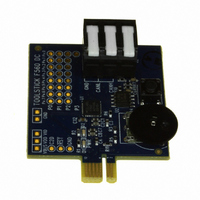TOOLSTICK560DC Silicon Laboratories Inc, TOOLSTICK560DC Datasheet - Page 208

TOOLSTICK560DC
Manufacturer Part Number
TOOLSTICK560DC
Description
DAUGHTER CARD TOOLSTICK F560
Manufacturer
Silicon Laboratories Inc
Series
ToolStickr
Type
MCUr
Specifications of TOOLSTICK560DC
Contents
Daughter Card
Processor To Be Evaluated
C8051F55x, C8051F56x, C8051F57x
Interface Type
USB
Operating Supply Voltage
2.7 V to 3.6 V
Lead Free Status / RoHS Status
Lead free / RoHS Compliant
For Use With/related Products
C8051F55x, C8051F56x, C8051F57x
For Use With
336-1345 - TOOLSTICK BASE ADAPTER336-1182 - ADAPTER USB DEBUG FOR C8051FXXX
Lead Free Status / Rohs Status
Lead free / RoHS Compliant
Other names
336-1719
- Current page: 208 of 302
- Download datasheet (3Mb)
C8051F55x/56x/57x
21. Controller Area Network (CAN0)
Important Documentation Note : The Bosch CAN Controller is integrated in the C8051F550/1/4/5, ‘F560/
1/4/5/8/9, and ‘F572/3 devices. This section of the data sheet gives a description of the CAN controller as
an overview and offers a description of how the Silicon Labs CIP-51 MCU interfaces with the on-chip
Bosch CAN controller. In order to use the CAN controller, refer to Bosch’s C_CAN User’s Manual as an
accompanying manual to the Silicon Labs’ data sheet.
The C8051F550/1/4/5, ‘F560/1/4/5/8/9, and ‘F572/3 devices feature a Control Area Network (CAN) con-
troller that enables serial communication using the CAN protocol. Silicon Labs CAN facilitates communica-
tion on a CAN network in accordance with the Bosch specification 2.0A (basic CAN) and 2.0B (full CAN).
The CAN controller consists of a CAN Core, Message RAM (separate from the CIP-51 RAM), a message
handler state machine, and control registers. Silicon Labs CAN is a protocol controller and does not pro-
vide physical layer drivers (i.e., transceivers). Figure 21.1 shows an example typical configuration on a
CAN bus.
Silicon Labs’ CAN operates at bit rates of up to 1 Mbit/second, though this can be limited by the physical
layer chosen to transmit data on the CAN bus. The CAN processor has 32 Message Objects that can be
configured to transmit or receive data. Incoming data, message objects and their identifier masks are
stored in the CAN message RAM. All protocol functions for transmission of data and acceptance filtering is
performed by the CAN controller and not by the CIP-51 MCU. In this way, minimal CPU bandwidth is
needed to use CAN communication. The CIP-51 configures the CAN controller, accesses received data,
and passes data for transmission via Special Function Registers (SFRs) in the CIP-51.
Silicon Labs MCU
CAN Protocol Device
CAN Protocol Device
CANTX
CANRX
CAN
CAN
CAN
Transceiver
Transceiver
Transceiver
Isolation/Buffer (Optional)
Isolation/Buffer (Optional)
Isolation/Buffer (Optional)
CAN_H
R
R
CAN_L
Figure 21.1. Typical CAN Bus Configuration
208
Rev. 1.1
Related parts for TOOLSTICK560DC
Image
Part Number
Description
Manufacturer
Datasheet
Request
R

Part Number:
Description:
KIT TOOL EVAL SYS IN A USB STICK
Manufacturer:
Silicon Laboratories Inc
Datasheet:

Part Number:
Description:
TOOLSTICK DEBUG ADAPTER
Manufacturer:
Silicon Laboratories Inc
Datasheet:

Part Number:
Description:
TOOLSTICK BASE ADAPTER
Manufacturer:
Silicon Laboratories Inc
Datasheet:

Part Number:
Description:
TOOLSTICK DAUGHTER CARD
Manufacturer:
Silicon Laboratories Inc
Datasheet:

Part Number:
Description:
TOOLSTICK DAUGHTER CARD
Manufacturer:
Silicon Laboratories Inc
Datasheet:

Part Number:
Description:
TOOLSTICK DAUGHTER CARD
Manufacturer:
Silicon Laboratories Inc
Datasheet:

Part Number:
Description:
TOOLSTICK PROGRAMMING ADAPTER
Manufacturer:
Silicon Laboratories Inc
Datasheet:

Part Number:
Description:
TOOLSTICK DAUGHTER CARD
Manufacturer:
Silicon Laboratories Inc
Datasheet:

Part Number:
Description:
KIT STARTER TOOLSTICK
Manufacturer:
Silicon Laboratories Inc
Datasheet:

Part Number:
Description:
KIT UNIVERSITY TOOLSTICK STARTER
Manufacturer:
Silicon Laboratories Inc
Datasheet:

Part Number:
Description:
DAUGHTER CARD TOOLSTICK F330
Manufacturer:
Silicon Laboratories Inc
Datasheet:

Part Number:
Description:
CARD DAUGHTER UNIVRSTY TOOLSTICK
Manufacturer:
Silicon Laboratories Inc
Datasheet:

Part Number:
Description:
DAUGHTER CARD TOOLSTICK F582
Manufacturer:
Silicon Laboratories Inc
Datasheet:

Part Number:
Description:
DAUGHTER CARD TOOLSTICK F500
Manufacturer:
Silicon Laboratories Inc
Datasheet:

Part Number:
Description:
DAUGHTER CARD TOOLSTICK F540
Manufacturer:
Silicon Laboratories Inc
Datasheet:










